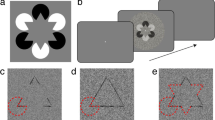Abstract.
This review article illustrates that mammals, birds and insects are able to perceive illusory contours. Illusory contours lack a physical counterpart, but monkeys, cats, owls and bees perceive them as if they were real borders. In all of these species, a neural correlate for such perceptual completion phenomena has been described. The robustness of neuronal responses and the abundance of cells argue that such neurons might indeed represent a neural correlate for illusory contour perception. The internal state of an animal subject (i.e., alert and behaving) seems to be an important factor when correlating neural activity with perceptual phenomena. The fact that the neural network necessary for illusory contour perception has been found in relatively early visual brain areas in all tested animals suggests that bottom-up processing is largely sufficient to explain such perceptual abilities. However, recent findings in monkeys indicate that feedback loops within the visual system may provide additional modulation. The detection of illusory contours by independently evolved visual systems argues that processing of edges in the absence of contrast gradients reflects fundamental visual constraints and not just an artifact of visual processing.
Similar content being viewed by others
Author information
Authors and Affiliations
Additional information
Electronic Publication
Rights and permissions
About this article
Cite this article
Nieder, A. Seeing more than meets the eye: processing of illusory contours in animals. J Comp Physiol A 188, 249–260 (2002). https://doi.org/10.1007/s00359-002-0306-x
Accepted:
Published:
Issue Date:
DOI: https://doi.org/10.1007/s00359-002-0306-x




